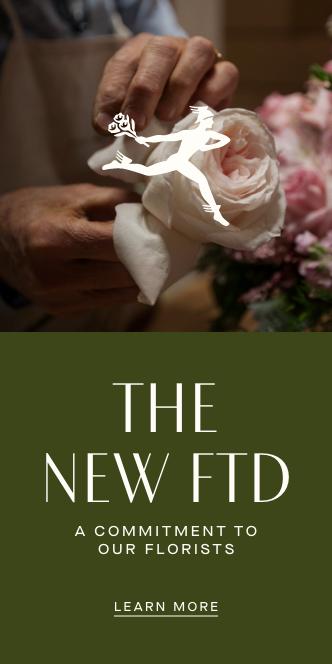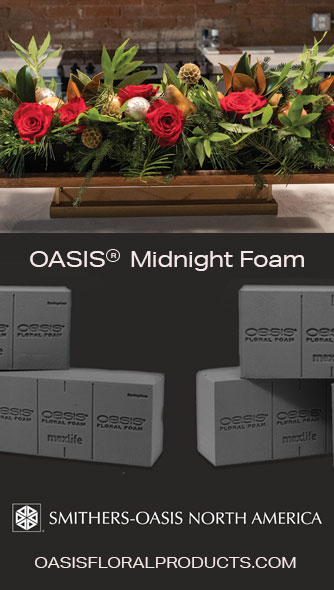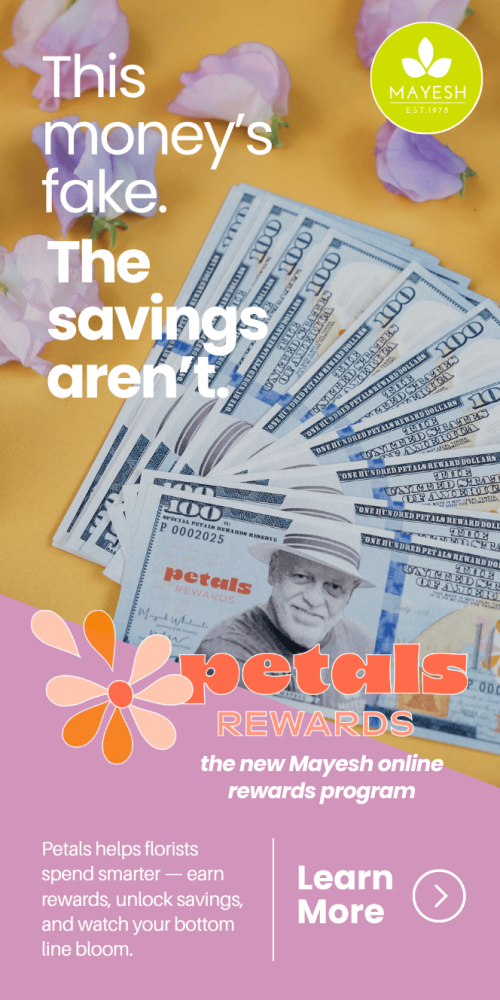How to best manage your advertising on social media.
By Andrew Joseph
THE ADVANTAGES OF ADVERTISING ONLINE
Certainly, you’re aware of the benefits of social media advertising for flower businesses. While there is no “easy” button to push to create the success you want, there are some gains you don’t want to miss out on. If you’re not doing so already, begin reaping these six benefits from online advertising:
1. Increased Brand Awareness: Social media offers businesses access to a vast, diverse audience, expanding brand visibility and breaking geographic limitations. Small-town floral designers can now reach distant customers—as long as they can ship securely. Alternatively, your flower shop can partner with trusted local florists to fulfill orders, sharing the profits while still serving faraway customers.
2. Targeted Advertising: Social media platforms offer advanced targeting options, enabling companies to reach specific demographics, interests and behaviors. Or ads can be set to only target people living in a specific city.
3. Engagement with Customers: Social media allows for direct, real-time interaction with customers through comments, messages and reviews. This two-way communication not only builds relationships but also fosters a sense of community.
4. Showcasing Products: High-quality graphics and videos can display flower arrangements, highlight special offers and sales or promote events. Leveraging images effectively can significantly boost your visibility, attract potential customers and cultivate a loyal following around your brand. It allows customers and would-be customers to see your design skills, as well as the fun to be had in a flower-arranging class you might offer.
5. Lower Costs: Compared to traditional advertising methods, social media advertising can be more cost-effective, especially for small and medium-sized businesses. It allows you to reach your target audience, track performance and engage with customers, all on a smaller budget.
6. Analytics and Insights: Social media platforms provide detailed analytics and insights, helping flower businesses track the performance of their ads and make data-driven decisions.
For example, the following key metrics are especially useful:
Impressions: The number of times your ad was displayed to users, which helps you understand the reach of your campaign.
Clicks: The number of times users clicked on your ad, which indicates the level of interest generated by your ad.
Click-Through Rate (CTR): The percentage of people who clicked on your ad after seeing it. A higher CTR suggests that your ad is engaging and relevant to your audience.
Conversions: The number of desired actions taken by users after clicking on your ad, such as making a purchase, signing up for a newsletter or filling out a contact form. It helps measure the effectiveness of your ad in driving specific outcomes.
Pay Per Click (PPC) or Cost Per Click (CPC): The average cost you pay each time someone clicks on your ad. Monitoring PPC helps you manage your budget and optimize your ad spend.
Cost Per Conversion (CPC): The average cost you pay to get a user to take a desired action, which helps you understand the cost-effectiveness of your campaign in achieving your goals.
Return on Ad Spend (ROAS): The revenue generated from your ad campaign divided by the cost of the campaign. A higher ROAS indicates a more profitable campaign.
Engagement: The number of likes, shares, comments and saves show how users are interacting with your content. This data can indicate levels of interest and active engagement.
Audience Insights: Information about the demographics, interests and behaviors of the people who interact with your ads. This helps you refine your targeting and create more relevant ads.
Ad Delivery Insights: Data on how and when your ads are being shown, including the devices and locations where they are viewed. This helps you optimize your ad delivery for better performance.
Lifetime Value (LTV): The total value a customer brings to your business over their entire relationship with you. Understanding LTV helps you assess the long-term impact of your ad campaigns.

By leveraging these detailed analytics and insights, flower businesses can make informed decisions, optimize their advertising efforts and achieve better results. Now that’s the why, as in why you need to use social media advertising to increase your business opportunities.
Advertising via social media has become an essential tool for businesses of all sizes—so why should the flower industry be any different? Thanks to platforms like Facebook and Instagram, florists now have access to a wide audience that can be targeted with precision.
Florists’ Review wants you to be confident in how you spend your money on social media advertising. To do so requires a strategic approach and an understanding of the various tools and techniques available.
UNDERSTANDING ONLINE ADVERTISING
Paid online advertising, also known as pay-per-click (PPC) advertising, involves paying a fee each time someone clicks on your ad. This is different from traditional advertising, which uses print, radio and television, and usually requires upfront payment—and a bigger budget—for ads, regardless of engagement. The PPC model allows businesses to drive traffic to their websites, generate leads and increase sales. The most common platforms for PPC advertising include search engines like Google and social media platforms. In this article, we’ll focus specifically on social media advertising. As mentioned in “The Advantages of Advertising Online” (page TK), it’s a less expensive way to reach your target audience, track performance and engage with customers.
SETTING GOALS
Before diving into paid online advertising, it’s crucial—regardless of your flower business scale—to define your goals. Ask yourself and answer: Are you looking to increase brand awareness, drive website traffic, generate leads or boost sales?
You can pick just one or all. And while all are interrelated, getting results for multiple goals takes more time and effort and can cost you more money to achieve. Your choice of goals will determine the type of ads you create, the platforms you choose and the metrics you track.
SELECTING THE RIGHT PLATFORMS

Each social media platform offers unique features and audiences—and there are multiple venues to choose from when it comes to paid online advertising. Here’s a brief overview of some of the more popular platforms to consider.
Facebook: One of the largest advertising platforms, it boasts more than 3 billion active users, with nearly 200 million in the United States. Facebook offers a wide range of ad formats, including image ads, video ads, carousel ads and slideshow ads. The platform’s targeting options are highly sophisticated, allowing you to reach specific demographics, interests and behaviors.
Instagram: This platform has more than 2 billion users globally, with nearly 170 million active users in the United States. It’s a highly visual platform that’s well-suited for brands with strong visual content—so floral designers, take note. Instagram ads include photo ads, video ads and story ads. Because it is owned by Facebook, it shares similar targeting options, making it easy to reach your desired audience.
X: Formerly known as Twitter, this platform offers promoted tweets, promoted accounts and promoted trends. These ads appear in users’ timelines and can be targeted based on keywords, interests and demographics. There are more than 50 million active users in the United States.
LinkedIn: Ideal for business-to-business advertising, this platform allows you to target professionals based on their job titles, industries and company sizes. LinkedIn ads include sponsored content, sponsored InMail and display ads. It has about 230 million active users in the United States. As a florist, you may not be interested in advertising to specific businesses. But if you grow, sell or distribute plants, this might be a platform worth considering.
Pinterest: This is a visual discovery platform that’s great for brands in industries like fashion, home decor and DIY projects. Pinterest ads include promoted pins and promoted video pins. There are roughly 90 million active users in the United States.
CREATING EFFECTIVE ADS
To produce successful ads for social media, you should focus on three key elements: visuals, copy and call to action (CTA). Here’s some advice for each of these elements:
- Visuals: Use high-quality images or videos that are relevant to your product or service. Ensure your visuals are eye-catching and stand out in users’ feeds. Use consistent branding to build recognition and trust.
- Copy: Keep your ad copy concise. Highlight the unique selling points of your product or service. Use persuasive language that encourages users to act.
- Call to Action: Include a clear and compelling CTA, such as “Shop Now,” “Learn More” or “Sign Up.” Make sure your CTA stands out and is easy to find. Test different CTAs to see which ones perform best.
TARGETING YOUR AUDIENCE
In case you didn’t know, your online activities—the websites you visit, the items you browse but don’t buy, as well as the purchases you make—are all tracked by bots. This allows online platforms to monitor your behavior and “assist” you, even if you’d rather not receive any help.
This presents an opportunity for you, as a business owner, to refine your advertising strategy and target your audience more precisely. Why waste money advertising to all 3 billion Facebook users, for example? Even narrowing the scope down to North America gets you users in the United States, Canada and Mexico. Is that your target advertising market? Even then, is every American Facebook user your target? No, of course not.
Effective targeting is key to the success of your online advertising campaigns. Here are some tips for determining your specific audience:
Demographics: Target users based on age, gender, location and language. While you may correctly believe that everyone from 18 to 100 is a potential customer to purchase your flowers, you can still skew your ad messaging to target a specific age group. Maybe your advertising plan caters to women aged 25 to 40 who live in your state. If you are selling flowers for an upcoming ethnic holiday, you could even target the language spoken around that holiday—such as Hindi for the festival of lights known as Diwali.
Interests: Reach users who have shown interest in topics related to your product or service. Perhaps you can focus on those who have previously purchased tropical plants or orchids from you, as opposed to cut flowers. Or maybe you focus on those looking for holiday gift baskets rather than bouquets. The point is that you are in control of how you want to narrow the parameters of your target audience.
Behaviors: Select social media users based on their online behaviors, such as recent purchases or website visits. For instance, you can create an advertising campaign to single out those who may have recently purchased online chocolates, teddy bears or non-floral gift baskets.
Custom Audiences: Use your existing customer data to create tailor-made audiences and retarget past visitors. An example of a customized audience could involve setting parameters to earmark visitors to your website who added items to their checkout cart but did not to complete the purchase. Rather than abandon hope, you can target your ad campaign towards such individuals. After all, they showed enough interest to consider purchasing something. Maybe they were sidetracked by a power outage or second-guessed their budget in the moment. Or perhaps the person they were buying flowers for walked into the room. Whatever the reason, get them back with a targeted abandoned cart campaign. Or, instead, create a campaign that targets your most valued repeat customers—set up a loyalty program. Or focus on everyone who has ever purchased from you and send out an event promotion just for them.
BUDGETING AND BIDDING
How much are you willing to spend on online advertising? After you decide, set a daily or lifetime (of the ad campaign) limit. In addition, select a bidding strategy that aligns with your goals. A bid strategy refers to the approach you choose to determine how much you’re willing to pay for a given advertising placement or action.
Depending on the social media platform, there are different bidding strategies to choose from. Some options include:
Maximize Clicks: This approach aims to get the most clicks possible. It’s ideal for increasing your website traffic or brand exposure, especially on a limited budget.
Cost Per Mille (CPM): Also known as cost per impression, CPM focuses on reaching a larger audience by paying per 1,000 impressions (each time an ad appears on screen, regardless of whether the ad is clicked). This approach pairs well with brand awareness campaigns.
Cost Per Acquisition or Action (CPA): CPA bidding gives you tight control over what you spend. Advertisers only pay a fee each time a desired action, like a purchase, is completed by a user. Essentially, it’s the same thing as cost per conversion.
Monitor your online advertising campaigns regularly. Remember that social media platforms provide detailed analytics and insights, helping businesses track ad performance. Make tweaks as needed to optimize your performance.
TIPS FOR SUCCESS
If only there were a one-size-fits-all solution to guarantee that online advertising would work flawlessly to attract as many new customers as you desire. Unfortunately, no such magic formula exists. However, there are strategies you can try to bring you closer to that ideal of success. Here are some more tips to help you effectively manage your online advertising campaigns:
Test and Experiment: Continually test different ad creatives, targeting options and bid strategies to find what works best.
Stay Updated: Keep current with the latest trends and updates in social media advertising to stay ahead of the competition or just for your own peace of mind.
Engage with Your Audience: Respond to comments and messages to build a relationship with your audience and increase engagement.
Use Analytics Tools: Review the analytics provided by the social media platforms to gain insights and make data-driven decisions to enhance your ad campaigns.
Managing paid online advertising can be a complex but rewarding process. By setting clear goals, choosing the right platforms, creating effective ads, targeting your audience and continually optimizing your campaigns, you can achieve significant results and drive your flower business forward.























